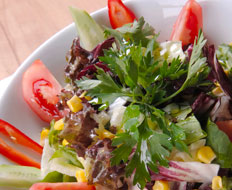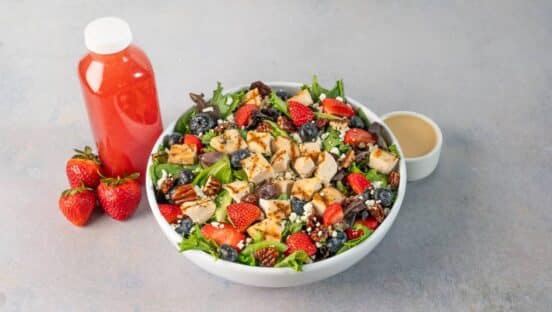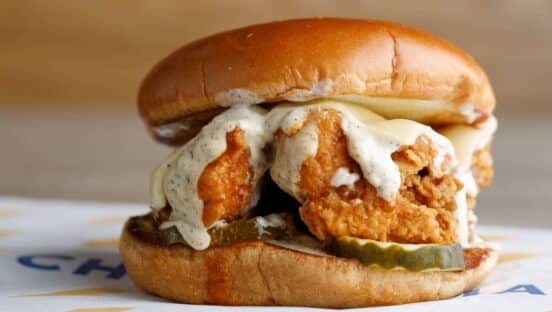Menu-development professionals for fast-food chains have probably watched enviously as some of their fast-casual competitors have unveiled salads that are both too elaborate and too expensive to replicate at their concepts.
Cosi’s Autumn Apple Chicken Salad, for instance—grilled chicken, apples, candied pistachios, dried cranberries, Feta, mixed greens, and caramel vinaigrette—might well be a profitable offering with Cosi’s business model. Likewise, Au Bon Pain’s Turkey, Apple, Brie, and Spinach Salad—fresh spinach with antibiotic-free turkey, Brie, apples, cranberries, walnuts, and maple-walnut dressing—makes sense in the context of its more upscale chain. But it’s hard to imagine salads of this complexity being viable offerings at, say, McDonald’s or Domino’s, where penny-pinching guests would chafe at the prices chains would have to charge to make such high-end salads available. The operational challenges associated with assembling these creative assortments would also, in many cases, be prohibitive.
The reality, for many quick-serve chains, is it isn’t always possible to build an all-new salad from the ground up. Fortunately, there are some efficient and delicious shortcuts. With a judicious eye, menu developers can add or change out just one or two key ingredients, particularly dressings and toppings, and turn a humdrum salad into something much, much more. In each example I’ll provide, flavor is the driver. The one critical point to remember about quick-serve salads is that every component on the plate has to contribute in some measure to the depth and breadth of the flavor palette. With that in mind, let’s take a look at some options for upgrading standard-issue salads—on a budget—for maximum impact.
Dressings can be blessings
No other single element can do as much to change the entire complexion of a salad with minimum fuss as dressing. The difference between a salad drenched in Thousand Island dressing (remember that stuff?) and one drizzled with a delicate vinaigrette is chasmic, even if what lies underneath is identical.
Given that vinaigrettes are the single most popular dressing type after the ubiquitous Caesar, a simple first step toward reinventing an uninspired salad could be to home in on the number of permutations available within that relatively narrow category. On the sweet side, there are variants ranging from caramel and maple-walnut to blueberry balsamic, strawberry, pomegranate, honey-tangerine, cranberry, and açai (to name a few).
On the savory/spicy side, a standard vinaigrette can be revved up with the addition of chipotle, Sriracha, Cholula, Thai chile, spicy sesame, tomatillo, and many other exotic imports. Each of these provocative flavors has already found favor among Millennials of all stripes, and depending on which varieties you offer, their appeal to Latino and Asian consumers is likely to be considerable.
From “super ingredients” to other trendy assortments
While dressings may be the highest-impact ingredient category, there are numerous others whose flavor profiles can transform the pedestrian and prosaic into the new and novel. So-called super ingredients—spinach, escarole, kale, chard, chicories, arugula—can add a serious nutritional boost to a salad, or turn it from a side dish into an entrée. Grains are terrific for imparting texture, nuttiness, fiber, and, in some cases, protein. From quinoa to farro, spelt, wild rice, black rice, bulgur, and wheat berries, there is a vast range of options worth considering. And in the broad category of “other,” we have selections such as pumpkin seeds, pine nuts, hemp and chia seeds, and flax seed, as well as increasingly popular legumes and vegetables such as chickpeas, sweet potato, orange and purple cauliflower, and Roman broccoli. All are commonly available, all bring something remarkable to a standard salad, and all offer potential health benefits.
Top it with cheeses, croutons, and fruit
Space won’t allow me to elaborate ad infinitum on the different ways cheeses, croutons, and fruit can be deployed to enhance the flavor and character of your salads, but let’s list some compelling ones, shall we? Feta, Goat, Cotija, Burrata, Mozzarella, fried Parmesan chips, and Gorgonzola have the power to liven up any old pile of greens, and because they are so intensely flavored, a small amount goes a long way. Croutons, broadly defined, can be pieces of any baked good, so it’s not just possible, but advisable, to investigate options like croissant croutons, cracker croutons, polenta croutons, quick-bread croutons, or specialty-bread croutons, including those made from banana, carrot, pumpkin, or zucchini loaves. And then there’s fruit, which can add complexity, seasonal accents, a health halo, and the perfect infusion of sweetness, whether we’re talking apple or pear slices, pomegranate, berries, citrus, stone fruits, grapes … the list goes on.
Again, the point is that it isn’t necessary to start from scratch, or concoct a whole new offering, to juice up your salads. As in the case of a wardrobe—where a new scarf, necktie, sweater, or other accent can turn an otherwise unremarkable outfit into something special—with salads, simple substitutions and additions, strategically and smartly incorporated, can deliver a full-on flavor makeover capable of generating new interest and attention among quick-serve customers. So go ahead and try on something new. It’ll look good on you.











